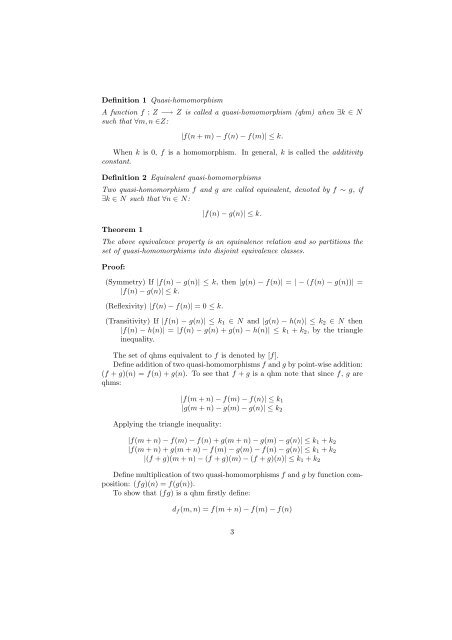The Efficient Real Numbers - Macquarie University
The Efficient Real Numbers - Macquarie University
The Efficient Real Numbers - Macquarie University
You also want an ePaper? Increase the reach of your titles
YUMPU automatically turns print PDFs into web optimized ePapers that Google loves.
Definition 1 Quasi-homomorphism<br />
A function f : Z −→ Z is called a quasi-homomorphism (qhm) when ∃k ∈ N<br />
such that ∀m,n ∈Z:<br />
|f(n + m) − f(n) − f(m)| ≤ k.<br />
When k is 0, f is a homomorphism. In general, k is called the additivity<br />
constant.<br />
Definition 2 Equivalent quasi-homomorphisms<br />
Two quasi-homomorphism f and g are called equivalent, denoted by f ∼ g, if<br />
∃k ∈ N such that ∀n ∈ N:<br />
<strong>The</strong>orem 1<br />
|f(n) − g(n)| ≤ k.<br />
<strong>The</strong> above equivalence property is an equivalence relation and so partitions the<br />
set of quasi-homomorphisms into disjoint equivalence classes.<br />
Proof:<br />
(Symmetry) If |f(n) − g(n)| ≤ k, then |g(n) − f(n)| = | − (f(n) − g(n))| =<br />
|f(n) − g(n)| ≤ k.<br />
(Reflexivity) |f(n) − f(n)| = 0 ≤ k.<br />
(Transitivity) If |f(n) − g(n)| ≤ k1 ∈ N and |g(n) − h(n)| ≤ k2 ∈ N then<br />
|f(n) − h(n)| = |f(n) − g(n) + g(n) − h(n)| ≤ k1 + k2, by the triangle<br />
inequality.<br />
<strong>The</strong> set of qhms equivalent to f is denoted by [f].<br />
Define addition of two quasi-homomorphisms f and g by point-wise addition:<br />
(f + g)(n) = f(n) + g(n). To see that f + g is a qhm note that since f, g are<br />
qhms:<br />
Applying the triangle inequality:<br />
|f(m + n) − f(m) − f(n)| ≤ k1<br />
|g(m + n) − g(m) − g(n)| ≤ k2<br />
|f(m + n) − f(m) − f(n) + g(m + n) − g(m) − g(n)| ≤ k1 + k2<br />
|f(m + n) + g(m + n) − f(m) − g(m) − f(n) − g(n)| ≤ k1 + k2<br />
|(f + g)(m + n) − (f + g)(m) − (f + g)(n)| ≤ k1 + k2<br />
Define multiplication of two quasi-homomorphisms f and g by function composition:<br />
(fg)(n) = f(g(n)).<br />
To show that (fg) is a qhm firstly define:<br />
df(m,n) = f(m + n) − f(m) − f(n)<br />
3
















